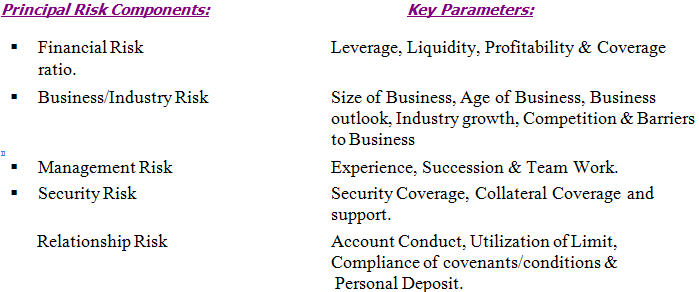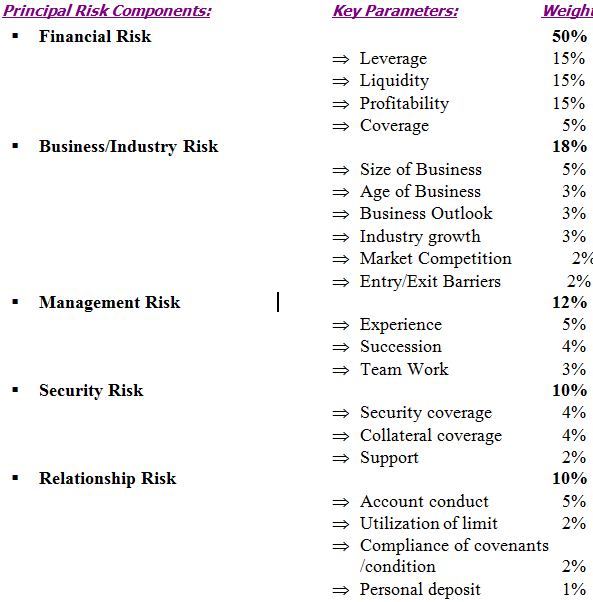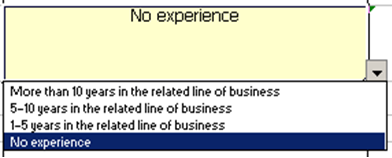Definition Of Credit Risk Grading (CRG)
The Credit Risk Grading (CRG) is a collective definition based on the pre-specified scale and reflects the underlying credit-risk for a given exposure.
A Credit Risk Grading deploys a number/ alphabet/ symbol as a primary summary indicator of risks associated with a credit exposure.
Credit Risk Grading is the basic module for developing a Credit Risk Management system.
Function OF Credit Risk Grading
Well-managed credit risk grading systems promote bank safety and soundness by facilitating informed decision-making. Grading systems measure credit risk and differentiate individual credits and groups of credits by the risk they pose. This allows bank management and examiners to monitor changes and trends in risk levels. The process also allows bank management to manage risk to optimize returns.
Use Of Credit Risk Grading
The Credit Risk Grading matrix allows application of uniform standards to credits to ensure a common standardized approach to assess the quality of individual obligor, credit portfolio of a unit, line of business, the branch or the Bank as a whole.
As evident, the CRG outputs would be relevant for individual credit selection, wherein either a borrower or a particular exposure/facility is rated. The other decisions would be related to pricing (credit-spread) and specific features of the credit facility. These would largely constitute obligor level analysis.
Risk grading would also be relevant for surveillance and monitoring, internal MIS and assessing the aggregate risk profile of a Bank. It is also relevant for portfolio level analysis.
The Chain Of Lending Process
![]()
1. Application
Applicant applies for the loan in the prescribed form of the bank describing the types and purpose of loan.
2. Sanction
A. Collecting credit information about the applicant to determine the credit worthiness of the borrower. Sources of information
- Personal Investigation, Confidential Report from other bank, Head Office/Branch/Chamber of Commerce.
- CIB (Central Information Bureau) report from Central Bank.
B. Evaluation of compliance with its lending policy.
C. Evaluating the proposed security
D. If loan amount exceeds 50 lac then bank goes for CRG Analysis.
E. CRG is must for the loan exceeding one corer – as ordered by Bangladesh Bank.
LRA has described at the end of this chapter.
3. Documentation
- a. Then bank prepare a loan proposal which contains terms and conditions of loan for approval of H.O. or Manager.
- b. Takes the necessary papers and signatures from borrower
4. Disbursement
A loan Account is opened.
Customer A/C————————-Dr.
Respective Loan A/C —————Cr.
Securities:
To make the loan secured, charging sufficient security on the credit facilities is very important. The banker cannot afford to take the risk of non-recovery of the money lent. CB charges the following two types of security, –
Primary security: These are the security taken by the ownership of the items for which bank provides the facility.
Collateral security: Collateral securities refer to the securities deposited by the third party to secure the advance for the borrower in narrow sense. In wider sense, it denotes any type of security on which the bank has a personal right of action on the debtor in respect of the advance.
Modes of Charging Security:
There are different modes of charging securities are exercised by the bank:
1. Pledge:
Pledge is the bailment of the goods as security for payment of a debt or performance of a promise. A pledge may be in respect of goods including stocks and share as well as documents of title to goods such as railway receipt, bills of lading, dock warrants etc. duly endorsed in bank’s favor.
2. Hypothecation:
In case of hypothecation, the possession and the ownership of the goods both rest the borrower. The borrower to the banker creates an equitable charge on the security. The borrower does this by executing a document known as Agreement of Hypothecation in favor of the lending bank.
3. Lien:
Lien is the right of the banker to retain the goods of the borrower until the loan is repaid. The bankers’ lien is general lien. A banker can retain all securities in his possession till all claims against the concern person are satisfied.
4. Mortgage:
According to section (58) of the Transfer of Property Act, 1882 mortgage is the ‘’transfer of an interest in specific immovable property for the purpose of securing the payment of money advanced or to be advanced by way of loan, existing or future debt or the performance of an engagement which may give rise to a pecuniary liability”. In this case the mortgagor does not transfer the ownership of the specific immovable property to the mortgagee, only transfers some of his rights as an owner. The banker exercises the equitable mortgage.
Number And Short Name Of Grades Used In The CRG
- The proposed CRG scale consists of 8 categories with Short names and Numbers are provided as follows:
| GRADING | SHORT NAME | NUMBER |
| Superior | SUP | 1 |
| Good | GD | 2 |
| Acceptable | ACCPT | 3 |
| Marginal/Watch list | MG/WL | 4 |
| Special Mention | SM | 5 |
| Sub standard | SS | 6 |
| Doubtful | DF | 7 |
| Bad & Loss | BL | 8 |
Credit Risk Grading Definition
A clear definition of the different categories of Credit Risk Grading is given as follows:
Superior – (SUP) – 1
Credit facilities, which are fully secured i.e. fully cash covered.
Credit facilities fully covered by government guarantee.
Credit facilities fully covered by the guarantee of a top tier international Bank.
Good – (GD) – 2
Strong repayment capacity of the borrower
The borrower has excellent liquidity and low leverage.
The company demonstrates consistently strong earnings and cash flow.
Borrower has well established, strong market share.
Very good management skill & expertise.
All security documentation should be in place.
Credit facilities fully covered by the guarantee of a top tier local Bank.
Aggregate Score of 85 or greater based on the Risk Grade Score Sheet
Acceptable – (ACCPT) – 3
These borrowers are not as strong as GOOD Grade borrowers, but still demonstrate consistent earnings.
Borrowers have adequate liquidity, cash flow and earnings.
Credit in this grade would normally be secured by acceptable collateral (1st charge over inventory / receivables / equipment / property).
Acceptable management
Acceptable parent/sister company guarantee
Aggregate Score of 75-84 based on the Risk Grade Score Sheet
Marginal/Watch list – (MG/WL) – 4
This grade warrants greater attention due to conditions affecting the borrower, the industry or the economic environment.
These borrowers have an above average risk due to strained liquidity, higher than normal leverage, thin cash flow and/or inconsistent earnings.
Weaker business credit & early warning signals of emerging business credit detected.
The borrower incurs a loss
Loan repayments routinely fall past due
Account conduct is poor, or other untoward factors are present.
Credit requires attention
Aggregate Score of 65-74 based on the Risk Grade Score Sheet
Special Mention – (SM) – 5
This grade has potential weaknesses that deserve management’s close attention. If left uncorrected, these weaknesses may result in a deterioration of the repayment prospects of the borrower.
Severe management problems exist.
Facilities should be downgraded to this grade if sustained deterioration in financial condition is noted (consecutive losses, negative net worth, excessive leverage),
An Aggregate Score of 55-64 based on the Risk Grade Score Sheet.
Substandard – (SS) – 6
Financial condition is weak and capacity or inclination to repay is in doubt.
These weaknesses jeopardize the full settlement of loans.
Bangladesh Bank criteria for sub-standard credit shall apply.
An Aggregate Score of 45-54 based on the Risk Grade Score Sheet.
Doubtful – (DF) – 7
Full repayment of principal and interest is unlikely and the possibility of loss is extremely high.
However, due to specifically identifiable pending factors, such as litigation, liquidation procedures or capital injection, the asset is not yet classified as Bad & Loss.
Bangladesh Bank criteria for doubtful credit shall apply.
An Aggregate Score of 35-44 based on the Risk Grade Score Sheet.
Bad & Loss – (BL) – 8
Credit of this grade has long outstanding with no progress in obtaining repayment or on the verge of wind up/liquidation.
Prospect of recovery is poor and legal options have been pursued.
Proceeds expected from the liquidation or realization of security may be awaited. The continuance of the loan as a bankable asset is not warranted, and the anticipated loss should have been provided for.
This classification reflects that it is not practical or desirable to defer writing off this basically valueless asset even though partial recovery may be affected in the future. Bangladesh Bank guidelines for timely write off of bad loans must be adhered to. Legal procedures/suit initiated.
Bangladesh Bank criteria for bad & loss credit shall apply.
An Aggregate Score of less than 35 based on the Risk Grade Score Sheet.
Regulatory Definition On Grading Of Classified Accounts
Irrespective of credit score obtained by a particular obligor, grading of the classified names should be in line with Bangladesh Bank guidelines on classified accounts, which is extracted from “PRUDENTIAL REGULATIONS FOR BANKS: SELECTED ISSUES” (updated till August 07, 2005) by Bangladesh Bank are presently as follows:
Basis for Loan Classification:
Any Continuous Loan if not repaid/renewed within the fixed expiry date for repayment will be treated as irregular just from the following day of the expiry date. This loan will be classified as Sub-standard if it is kept irregular for 6 months or beyond but less than 9 months, as `Doubtful’ if for 9 months or beyond but less than 12 months and as `Bad & Loss’ if for 12 months or beyond.
Any Demand Loan will be considered as Sub-standard if it remains unpaid for 6 months or beyond but not less then 9 months from the date of claim by the bank or from the date of forced creation of the loan; likewise the loan will be considered as ‘Doubtful’ and ‘Bad & Loss’ if remains unpaid for 9 months or beyond but less then 12 months and for 12 months and beyond respectively.
In case any instalment(s) or part of instalment(s) of a Fixed Term Loan is not repaid within the due date, the amount of unpaid instalment(s) will be termed as `defaulted instalments’.
In case of Fixed Term Loans, which are repayable within maximum 5 (five) years of time: –
If the amount of `defaulted instalments’ is equal to or more than the amount of instalment(s) due within 6 months, the entire loan will be classified as ‘Sub-standard’.
If the amount of ‘defaulted instalment’ is equal to or more than the amount of instalment(s) due within 12 months, the entire loan will be classified as ‘Doubtful’.
If the amount of ‘defaulted instalment’ is equal to or more than the amount of instalment(s) due within 18 months, the entire loan will be classified as ‘Bad & Loss
In case of Fixed Term Loans, which are repayable in more than 5 (five) years of time: –
□ If the amount of ‘defaulted instalment’ is equal to or more than the amount of instalment(s) due within 12 months, the entire loan will be classified as ‘Sub-standard.’
□ If the amount of ‘defaulted instalment’ is equal to or more than the amount of instalment(s) due within 18 months, the entire loan will be classified as ‘Doubtful’.
□ If the amount of ‘defaulted instalment ‘is equal to or more than the amount of instalment(s) due within 24 months, the entire loan will be classified as ‘Bad & Loss’.
Explanation: If any Fixed Term Loan is repayable at monthly instalment, the amount of instalment(s) due within 6 months will be equal to the amount of summation of 6 monthly instalments. Similarly, if repayable at quarterly instalment, the amount of instalment(s) due within 6 months will be equal to the amount of summation of 2 quarterly instalments.
How To Compute Credit Risk Grading
The following step-wise activities outline the detail process for arriving at credit risk grading.
Step I : Identify all the Principal Risk Components
Credit risk for counterparty arises from an aggregation of the following:
1. Quantitative Factor:
Financial Risk
2. Qualitative Factor
Business/Industry Risk
Management Risk
Security Risk
Relationship Risk
Each of the above mentioned key risk areas require be evaluating and aggregating to arrive at an overall risk grading measure.
a) Evaluation of Financial Risk:
Risk that counterparties will fail to meet obligation due to financial distress. This typically entails analysis of financials i.e. analysis of leverage, liquidity, profitability & interest coverage ratios. To conclude, this capitalizes on the risk of high leverage, poor liquidity, low profitability & insufficient cash flow.
b) Evaluation of Business/Industry Risk:
Risk that adverse industry situation or unfavorable business condition will impact borrowers’ capacity to meet obligation. The evaluation of this category of risk looks at parameters such as business outlook, size of business, industry growth, market competition & barriers to entry/exit. To conclude, this capitalizes on the risk of failure due to low market share & poor industry growth.
c) Evaluation of Management Risk:
Risk that counterparties may default as a result of poor managerial ability including experience of the management, its succession plan and team work.
d) Evaluation of Security Risk:
Risk that the bank might be exposed due to poor quality or strength of the security in case of default. This may entail strength of security & collateral, location of collateral and support.
e) Evaluation of Relationship Risk:
These risk areas cover evaluation of limits utilization, account performance, conditions/covenants compliance by the borrower and deposit relationship.
Step II: Allocate weightages to Principal Risk Components
According to the importance of risk profile, the following weightages are proposed for corresponding principal risks.
Principal Risk Components: Weight:
Financial Risk 50%
Business/Industry Risk 18%
Management Risk 12%
Security Risk 10%
Relationship Risk 10%
Show the Credit risk grading diagram below:

Principal Risk Components: Weight:
Show the Credit risk grading diagram below:

Step IV: Assign weight ages to each of the key parameters.

Step V: Input data to arrive at the score on the key parameters.
After the risk identification & weightage assignment process (as mentioned above), the next steps will be to input actual parameter in the score sheet to arrive at the scores corresponding to the actual parameters.
This manual also provides a well programmed MS Excel based credit risk scoring sheet to arrive at a total score on each borrower. The excel program requires inputting data accurately in particular cells for input and will automatically calculate the risk grade for a particular borrower based on the total score obtained. The following steps are to be followed while using the MS Excel program.
a) Open the MS XL file named, CRG_SCORE_SHEET
b) The entire XL sheet named, CRG is protected except the particular cells to input data.
c) Input data accurately in the cells which are BORDERED & are colored YELLOW.
|
d) Some input cells contain DROP DOWN LIST for some criteria corresponding to the Key Parameters. Click to the input cell and select the appropriate parameters from the DROP DOWN LIST as shown below.

e) All the cells provided for input must be filled in order to arrive at accurate risk grade.
f) We have also enclosed the MS Excel file named, CRG_Score_Sheet in CD ROM for use.
The following is the proposed Credit Risk Grade matrix based on the total score obtained by an obligor.
Number | Risk Grading | Short Name | Score |
1 | Superior | SUP |
|
2 | Good | GD | 85+ |
3 | Acceptable | ACCPT | 75-84 |
4 | Marginal/Watch list | MG/WL | 65-74 |
5 | Special Mention | SM | 55-64 |
6 | Sub-standard | SS | 45-54 |
7 | Doubtful | DF | 35-44 |
8 | Bad & Loss | BL | <35 |
Credit Risk Grading Process
Credit Risk Grading should be completed by a Bank for all exposures (irrespective of amount) other than those covered under Consumer and Small Enterprises Financing Prudential Guidelines and also under The Short-Term Agricultural and Micro – Credit.
For Superior Risk Grading (SUP-1) the score sheet is not applicable. This will be guided by the criterion mentioned for superior grade account i.e. 100% cash covered, covered by government & bank guarantee.
Credit risk grading matrix would be useful in analyzing credit proposal, new or renewal for regular limits or specific transactions, if basic information on a borrowing client to determine the degree of each factor is a) readily available, b) current, c) dependable, and d) parameters/risk factors are assessed judiciously and objectively. The Relationship Manager as per Data Collection Checklist as shown in Appendix-A should collect required information.
Relationship manager should ensure to correctly fill up the Limit Utilization Form as shown in Appendix-B in order to arrive at a realistic earning status for the borrower.
Risk factors are to be evaluated and weighted very carefully, on the basis of most up-to-date and reliable data and complete objectivity must be ensured to assign the correct grading. Actual parameter should be inputted in the Credit Risk Grading Score Sheet as shown in Appendix–C.
Credit risk grading exercise should be originated by Relationship Manager and should be an on-going and continuous process. Relationship Manager shall complete the Credit Risk Grading Score Sheet and shall arrive at a risk grading in consultation with a Senior Relationship Manager and document it as per Credit Risk Grading Form as shown in Appendix-D, which shall then be concurred by the Credit Officer in consultation with a Senior Credit Officer.
All credit proposals whether new, renewal or specific facility should consist of a) Data Collection Checklist, b) Limit Utilization Form c) Credit Risk Grading Score Sheet, and d) Credit Risk Grading Form.The credit officers then would pass the approved Credit Risk Grading Form to Credit Administration Department and Corporate Banking/Line of Business/Recovery Unit for updating their MIS/record.
The appropriate approving authority through the same Credit Risk Grading Form shall approve any subsequent change/revision i.e. upgrade or downgrade in credit risk grade.
Early Warning Signals (EWS)
Early Warning Signals (EWS) indicate risks or potential weaknesses of an exposure requiring monitoring, supervision, or close attention by management.
If these weaknesses are left uncorrected, they may result in deterioration of the repayment prospects in the Bank’s assets at some future date with a likely prospect of being downgraded to classified assets.
Early identification, prompt reporting and proactive management of Early Warning Accounts are prime credit responsibilities of all Relationship Managers and must be undertaken on a continuous basis.
Despite a prudent credit approval process, loans may still become troubled. Therefore, it is essential that early identification and prompt reporting of deteriorating credit signs be done to ensure swift action to protect the Bank’s interest. The symptoms of early warning signals as mentioned below are by no means exhaustive and hence, if there are other concerns, such as a breach of loan covenants or adverse market rumors that warrant additional caution, a Credit Risk Grading Form (Appendix-D)should be presented.
Irrespective of credit score obtained by any obligor as per the proposed risk grade score sheet, the grading of the account highlighted as Early Warning Signals (EWS) accounts shall have the following risk symptoms.
a) Marginal/Watch list (MG/WL – 4): if –
Any loan is past due/overdue for 60 days and above.
Frequent drop in security value or shortfall in drawing power exists.
b) Special Mention (SM – 5): if –
Any loan is past due/overdue for 90 days and above
Major document deficiency prevails (such deficiencies include but not limited to; board resolution for borrowing not obtained, sanction letter not accepted by client, charges/hypothecation over assets favoring bank not filed with Registrar, Joint Stock Companies, mortgage not in place, guarantees not obtained, etc.)
A significant petition or claim is lodged against the borrower.
The Credit Risk Grading Form of accounts having Early Warning Signals should be completed by the Relationship Manager and sent to the approving authority in Credit Risk Management Department. The Credit Risk Grade should be updated as soon as possible and no delay should be there in referring Early Warning Signal accounts or any problem accounts to the Credit Risk Management Department for their early involvement and assistance in recovery.
Exception To Credit Risk Grading
Head of Credit Risk Management may also downgrade/classify an account in the normal course of inspection of a Branch or during the periodic portfolio review. In such event, the Credit Risk Grading Form will then be filled up by Credit Risk Management Department and will be referred to Corporate Banking/Line of Business/Credit Administration Department/Recovery Unit for updating their MIS/records.
Recommendation for upgrading of an account has to be well justified by the recommending officers. Essentially complete removal of the reasons for downgrade should be the basis of any upgrading.
In case an account is rated marginal, special mention or unacceptable credit risk as per the risk grading score sheet, this may be substantiated and credit risk may be accepted if the exposure is additionally collateralized through cash collateral, good tangible collaterals and strong guarantees. These are exceptions and should be exceptionally approved by the appropriate approving authority.
Whenever required an independent assessment of the credit risk grading of an individual account may be conducted by the Head of Credit Risk Management or by the Internal Auditor documenting as to why the credit deteriorated and also pointing out the lapses.
If a Bank has its own well established risk grading system equivalent to the proposed credit risk grading or stricter, then they will have the option to continue with their own risk grading system.
Credit Risk Grading Review
Credit Risk Grading for each borrower should be assigned at the inception of lending and should be periodically updated. Frequencies of the review of the credit risk grading are mentioned below;
Number | Risk Grading | Short | Review frequency (at least) |
1 | Superior | SUP | Annually |
2 | Good | GD | Annually |
3 | Acceptable | ACCPT | Annually |
4 | Marginal/Watchlist | MG/WL | Half yearly |
5 | Special Mention | SM | Quarterly |
6 | Sub-standard | SS | Quarterly |
7 | Doubtful | DF | Quarterly |
8 | Bad & Loss | BL | Quarterly |
MIS On Credit Risk Grading
- Bank should have comprehensive MIS reports on credit risk grading to evaluate entire credit portfolio of the Bank. Format of such MIS reports on credit risk grading has been presented in
Credit Risk Grading Report (Consolidated)
Credit Risk Grading Report (Branch Wise)
Credit Risk Grading Report (Branch & Risk Grade Wise)
Credit Risk Grading Report (Grade Wise Borrower List)
- MIS reports as mentioned above should be prepared and circulated at least on a quarterly basis.
Credit Risk grading system is a dynamic process and various models are followed in different countries & different organization for measuring credit risk The goal of credit risk management is to maximize a bank’s risk adjusted rate of return by maintaining credit risk exposure within acceptable levels. The effective management of credit risk is a critical component of a comprehensive approach to risk management and essential to the long-term success of any banking organization.
Some More Parts-
Credit Risk Grading(CRG) In Southest Bank Limited (Part-1)
















